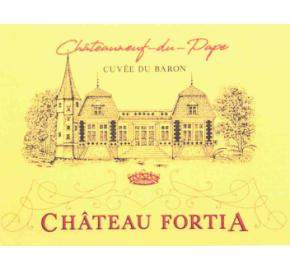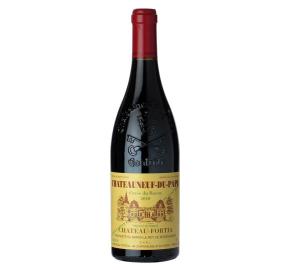Chateau Fortia - Chateauneuf-du-Pape - Cuvee du Baron 2020
- Producer Chateau Fortia
-
Blend
40% Grenache
15% Mourvedre
45% Syrah - Country France
- Region Rhone Valley
- Appellation Chateauneuf Du Pape
- UPC 7 85255 00927 4
Log in to view pricing and order online
Don't have an account? Register here
Item# 11012-20
Jeb Dunnuck
92-94pt
James Suckling
92pt
Wine Spectator
94pt
Description
Château Fortia is not a winery that chases good press on a whim. These are consistent, classic wines that faithfully represent the region’s terroir year after year. The Cuvée du Baron, which combines 45% Syrah with 40% Grenache, and 15% Mourvedre, was created in the memory of the Domaine’s founder, Baron Le Roy de Boiseaumarie. The wine was first released in 2001.
The wine went through a long, cool fermentation in small lots by varietal, then aged 18 months in old oak foudres prior to bottling. Deep garnet-purple in color, this is a wine with a dense, complex nose and notes of plum and cassis and garrigue on a medium-bodied palate.
Tasting notes
With a blend in which Grenache and Syrah have pride of place, its complexity, opulence and delicate spicy and ripe fruit aromas, the Cuvée du Baron veritably embodies the distinctiveness of our terroir. Intense ruby red color with purple hues.Complex and fine nose: mineral toasted notes, black fruit jam, spices. The mouth is frank from the start and rises in power throughout the tasting. Lots of fat and coating in the middle of the mouth, then a more taut and chiseled finish. Notes of fruit brandy, blueberry, spices. The tannins still require a little aging to fully soften. Very nice persistence.
History
Chateau Fortia is one of the older estates in Chateauneuf du Pape. In fact Chateau Fortia can date itself all the way back to its humble beginnings as a Southern Rhone Valley farm in 1763. The beautiful estate continued to expand over the years. The first label displaying the Chateau Fortia name was produced in 1930. Today Chateau Fortia is owned and managed by the Le Roy family who have been in charge of the property since the early part of the 20th century.
Even though most of their vines are in one large parcel, the soils are varied. They have a terroir of sand, clay, limestone and large rocks in their soil. The vineyard is planted to mostly Grenache with Syrah and a bit of Mourvedre.
Chateau Fortia is best when decanted for about 1-2 hours when young. This allows the wine to soften and open its perfume. Older vintages need very little decanting, just enough to remove the sediment. Their wines age very well and are usually very expressive with 4-6 years of bottle age. Of course that can vary slightly, depending on the vintage. In the best vintages the wine should be consumed within 5-18 years after the vintage
Chateau Fortia is best when decanted for about 1-2 hours when young. This allows the wine to soften and open its perfume. Older vintages need very little decanting, just enough to remove the sediment. Their wines age very well and are usually very expressive with 4-6 years of bottle age. Of course that can vary slightly, depending on the vintage. In the best vintages the wine should be consumed within 5-18 years after the vintage
Vinification
Harvested entirely by hand with sorting on the plot, the bunches are delicately picked and then transported in crates in order to ensure the perfect condition of all the grapes and to avoid any oxidation. Destemmed to the tune of 90%, the grapes are then transferred to concrete or stainless steel vats. Fermentation and 4 to 5 weeks of maceration make it possible to extract all the colour and aromas from the grapes. Cask-ageing of between 18 to 24 months allows the wine to gently flourish. It is then bottled and left to rest in our ageing cellars


